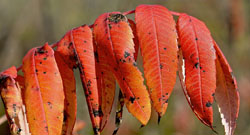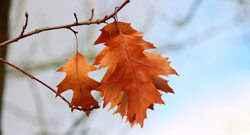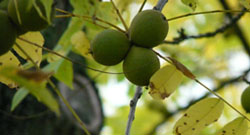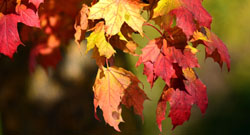
Trees
Rouge National Urban Park
There are several species of native trees and shrubs that grow throughout Rouge National Urban Park. Below is a list of a few that you might be able to spot while out in the park. Keep an eye out for how the leaves change with the seasons, especially in autumn!
Sugar Maple
Sugar maples are abundant throughout Rouge National Urban Park. Embodied on the Canadian flag, their characteristic leaves turn brilliant orange and red in the fall, producing a stunning display visible from the Vista Trail lookout.
Ironwood and Blue Beech
Ironwood and blue beech are small understory trees characteristic of the Carolinian Life Zone. Ironwood has oval leaves with sharp teeth and rough grey-brown bark. Though slow-growing, Ironwood has extremely dense, hard wood. Blue beech has oval leaves with fine teeth and smooth grey bark.
Apple Trees
If you look closely you may spot some old apple trees growing along the Orchard Trail, a remnant of this area’s agricultural past. Apple seeds were brought to the area by early settlers and apple orchards were once a common sight throughout the Rouge Valley.
Black Walnut
Black walnut trees can be found at the southern end of the Orchard Trail. They are identified by their dark, highly ridged bark and compound leaves (multiple leaflets attached to a single stem). In the fall these trees drop greenish-brown fruits that each contain a walnut. The fruits have a very distinctive pungent smell, similar to the smell of an orange. Black walnut trees produce a chemical called juglone that can inhibit the growth of nearby plants.
White Cedar
The abundance of white cedar trees that grow along the northern end of the route give the Cedar Trail its name. These small to medium sized trees are very hardy and slow-growing with red-brown furrowed bark and fan-shaped branches with small scaly leaves. Some white cedars growing along the Niagara Escarpment exceed 500 years in age, making them some of the oldest trees in Ontario.
White Pine and Red Pine
Both white pines and red pines grow along the second half of the Woodland Trail. White pines have grey-brown ridged bark and 6 to 12 cm long needles that grow in bunches of five, while red pines have reddish-pink bark and 10 to 16 cm long needles that grow in bunches of two. Old-growth white pines were once logged in the Rouge Valley and sent overseas to become ship masts in Europe. White pine is now the provincial tree of Ontario and all trees in Rouge National Urban Park are protected.
Red Oak
Red oak is one of the tree species that has been planted at the restoration sites in the Bob Hunter area of the park. Red oaks grow more slowly than some of the other planted species such as trembling aspen or white pine. These fast-growing species will help to re-establish proper soil and drainage conditions for these forests to thrive. Later, the replanted red oaks will act as natural seed sources, allowing the growth of new trees that will help transition these restored areas towards mature mixed hardwood forests.
Trembling Aspen
Trembling aspen is a fast-growing deciduous tree that can be found across Canada. It gets its name from its leaves, which appear to “tremble” when blowing in the wind, due to their flexible flattened stalks. Trembling aspen mainly spreads through root sprouts, forming clonal colonies. All the trees in a colony have the same characteristics and share a single root structure. Trembling aspen is often one of the first species to grow after a disturbance. Trembling aspen can be an important food source for many animals, including deer, beavers and snowshoe hare who eat the bark and twigs, and many species of birds who eat their buds and seeds.
Staghorn Sumac
Staghorn sumac is a large shrub or small tree with compound leaves (multiple leaflets attached to a single stem). Clusters of greenish flowers appear on the plants in late spring and turn into fuzzy red berries by late summer. The fruit stays on the trees throughout the winter, providing a source of food for birds. Staghorn sumac gets its name from the velvety texture of its branches, which resemble the antlers of a male deer (stag).
Fall Colours: A Natural Wonder
Every year in the Rouge, GTA and Ontario, a captivating natural process occurs in shrubs and trees that signals the start of autumn – the fall colours. While the colour change amazes us, it’s not a mystery. Let’s ‘decode’ what happens when trees and shrubs get ready for winter as you enjoy this annual display across the park.
Why are leaves green?
Trees that generate true leaves, like maples and oaks, are deciduous. Leaves are coloured by molecules called pigments. The pigment that causes leaves to be green is chlorophyll. Chlorophyll helps plants soak up sunlight energy, which, combined with air and water, is how plants produce food for themselves. This is called photosynthesis.
Why do leaves change colour?
In autumn when the weather starts to get colder and there is less sunlight, some plants stop making chlorophyll. Instead, those plants actually break down the chlorophyll into smaller molecules. When it is time for the leaves to fall, chlorophyll stops being produced and is broken down. This causes the ‘hidden’ pigment molecules to show.
Why do leaves fall off their branches?
Winter is cold and dry and there isn’t usually much sun to make food. It would take far too much energy for plants to keep their leaves healthy, so instead of keeping their leaves, most trees drop their leaves and seal the spots where the leaves were attached. During the winter, the trees will rest and live off the food they stored during the summer.
Why don’t trees like pines and spruces lose their needles?
Pines, spruces, hemlock and cedars are examples of coniferous trees. Their green leaves are called needles or scales, and they generate seeds in cones. The needles or scales have a protective layer so they can survive winter, so these trees are also called evergreens. The exception is the Tamarack or Larch. It has needles and cones but still loses all of its needles in the fall – it is a deciduous coniferous tree.
- Carotenoid pigment molecules are displayed as a vibrant orange
- Xanthophyll pigment molecules are displayed as yellow
- Anthocyanin pigment is only made in the fall and results in red, blue, pink or purple Tannins are made from waste left in the leaves and appear as brown/copper
- Tannins are made from waste left in the leaves and appear as brown/copper




Related links
- Date modified :